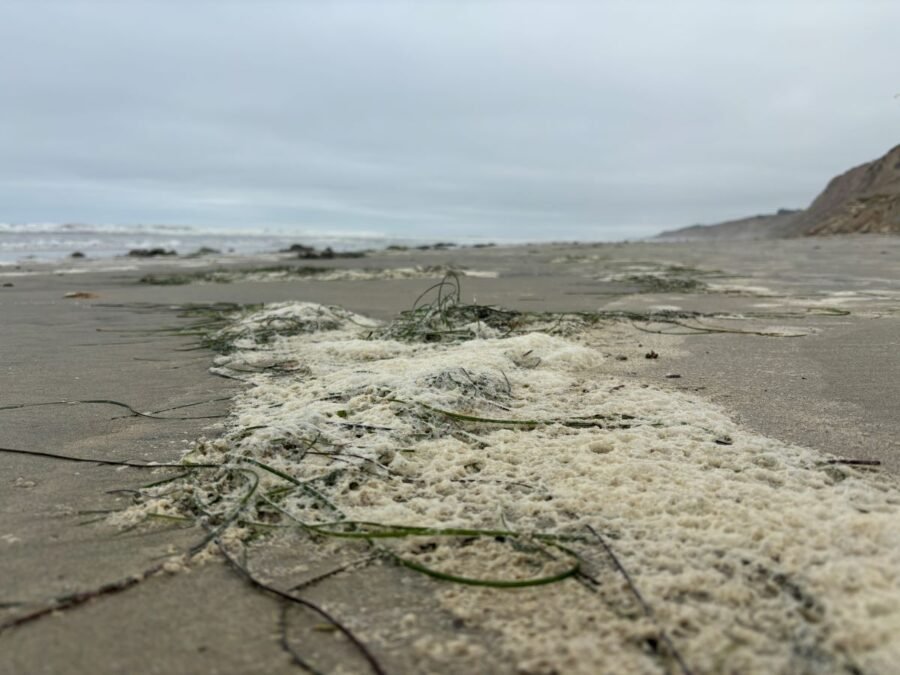Sea Foam and the Red Tide

Ever heard the term, “sea foam”? Sea foam, or, “spume” is yet another ocean phenomenon that occurs naturally and regularly. If you’ve ever been walking down the beach or even out for a swim, you might have noticed some thick, bubbly, foamy substance accumulating at the water surface and sometimes on the shoreline. That substance you’ve been seeing, that’s sea foam.
See here for updates on the latest red tide in So Cal.
What is sea foam?
Ocean water is comprised of a myriad of substances and matter. According to Duxbury, Mackenzie, and Byrne, “seawater is a complex mixture of 96.5 percent water, 2.5 percent salts, and smaller amounts of other substances, including dissolved inorganic and organic materials, particulates, and a few atmospheric gases.” (2018).
When heavy winds, strong currents, and large surf and swells occur, ocean water is churned up. This can cause the substances within the water to become “agitated”. We learned earlier in my article on the Red Tide that this agitation also causes the bioluminescent-glow of the phytoplankton.
This agitation combined with the natural breakdown of organic substance leads to the formation of sea foam. In fact, the formation of white sea foam along our beaches is a sign of a healthy ecosystem and it’s a regular and natural occurrence (US Department of Commerce & National Oceanic and Atmospheric Administration, 2013).
Is sea foam harmful?
As stated above, the formation of white, bubbly sea foam, is a sign of a healthy ecosystem. That being said, it generally does not pose any threat or harm to humans nor to fish and other organisms.
While a fluffy, white foam indicates a healthy ecosystem, if the foam holds a darker tint, it could indicate otherwise.
Sometimes, towards the tail-end of red tides (large algae blooms), a darker, reddish-brown tint of sea foam washes ashore . This again, is normal and natural. But, it has the potential to be harmful to the ecosystem as well as human health.
Why? As we learned in my article on the Red Tide, these phytoplankton can release toxins that aren’t good for ecosystems. When the foam accumulates on the shoreline, these toxins can become airborne and irritate the eyes of humans and pose a minor risk for those who have semi-compromised respiratory systems (US Department of Commerce & National Oceanic and Atmospheric Administration, 2013).
If these toxins can affect humans, they can surely harm birds and other coastal and marine life. But, this doesn’t mean you shouldn’t go out to the beach. Many would still argue that the benefits of being at the beach far outweigh this minor risk.
What does sea foam mean for the current red tide?

In mid-May of 2020, Southern California experienced one of the longer red tides to date. Toward the tail-end of the red tide, we witnessed a very pronounced build-up of “sea foam” washing up on our shoreline. But, not white sea foam… rather, a reddish-brown sea foam.
This means that more toxins are being released. It could irritate your eyes, your respiratory system and harm other parts of the ecosystem. But, there is a positive side to this, however.
You read earlier that there are multiple parts involved in the formation of sea foam; irritation and organic matter break down. The bright side here is that the organic matter, phytoplankton, is essentially dying off.
The red tide we are experiencing in 2024 is the most severe and prolonged red tide we’ve experienced since 2020 and it seems to be sticking around for now at least. We have begun to see the formation of seafoam (which is a very good sign) along some beaches, so as long as there are no new blooms that occur, fingers crossed we only have a week or two left of this season’s red tide.
Overview
The arrival of sea foam is a good sign when it comes to red tides. It means we’ve reached the light at the end of the tunnel. This organic substance breakdown correlates with the more natural coloring of the water in daylight hours.
While the glow is still present, that may simply be due to the level of irritation that has occurred. More bubbles = more glow, but, the truth is, when sea foam builds up, you can expect the red tide to diminish significantly.
If the sea foam is here and the red tide is dispersing, it’s time to get your gear and tackle ready for the summertime season! Check out my recommended light tackle set-up below:
- Rod: Okuma Celilo (8’6″ MA)
- Reel: Penn Battle II or III 4000 series
- Mainline: 15-pound monofilament
- Carolina Rig (descriptive article/video):
- Leader Line: 15-pound fluorocarbon
- Swivels: 15-19mm barrel swivels
- Hooks: size #2 or #4 owner mosquito hooks
- Weights: 1-oz egg weight
- Beads: 8mm fishing beads
Subscribe:
References:
1.) Duxbury, A., Mackenzie, F., & Byrne, R. (2018, August 14). Seawater. Retrieved May 17, 2020, from https://www.britannica.com/science/seawater
2.) US Department of Commerce, & National Oceanic and Atmospheric Administration. (2013, June 01). What is sea foam? Retrieved May 17, 2020, from https://oceanservice.noaa.gov/facts/seafoam.html
I paddle my kayak most days inside and outside in the ocean off Santa Cruz Harbor. Currently, there is noticeable red tide. As well, there is sea foam that accumulates at the breakwater entrance and drifts in and out. As I paddle through this sea foam, I can see it is oily. And can only guess it is from boats in the marina that have automatic bilge pumps operating. Contrary to the article, this sea foam, cannot be healthy for local birds, sealions, otters, and fish. On beach walks we regularly encounter deceased cormorants, grebes, even sea lions. ~skip allan, Capitola, CA..
I cannot speak on what it is your seeing exactly. I’m not familiar with boats and automatic bilge pumps. I don’t believe we’ve had any red tides this year so I doubt what your seeing is sea foam but given that I’m in SD, I really don’t know. A red tide has the potential to kill off all sorts of marina animals. But, the sea foam referred to in this article is indicative of the end of the red tide. Which is good. Hope this helps a little maybe.
Sorry, Santa Cruz*